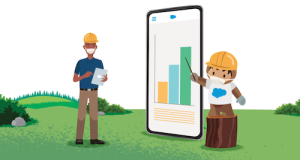Building materials companies are at a digital crossword. Whole sectors have been turbocharged by the power of digital solutions. However, the construction industry is lagging when it comes to digital adoption. In fact, construction scores just 1% on the digital index, making it one of the least digitised industries.
Trends in Architecture, Engineering, & Construction
How have construction firms adapted their business development processes during a crisis? Read Trends in Architecture, Engineering, & Construction to find out.

The slow pace of digitalisation is surprising in an industry with tight margins and a desire to mitigate risks. Both of these areas can be addressed through digital levers. The lack of digital empowerment can be frustrating for customers who now expect digital experiences, e-commerce capabilities, and flawless workflows.
The benefits of digital channels get clearer by the day. But the shift towards digital is just one of the trends shaping the industry for building materials companies.
Five Building materials trends set to transform the industry
1. Material innovation. From sustainable sourcing to 3D printing, product innovations are bringing new types of materials to market. And it’s happening faster than ever.
2. Modular building and off-site construction. Customers are looking for ways to improve designs and purchase products at scale. As a result, standardisation and pre-assembly are on the rise.
3. Sustainability and regulation. Today’s customers want better management of materials waste. They want transparency and traceability of their CO2 emissions across the value chain.
4. Shifting value pools. Consolidation in the construction industry, at both customer and supplier levels, is changing the way that the different players compete and make purchasing decisions.
5. End-to-end digitalisation. More building materials companies are introducing end-to-end digitalisation. By doing so, they can improve everything from procurement to customer satisfaction. Many are building digital routes to market in what has traditionally been an offline industry.
How Salesforce helps building materials companies address the digital imperative
Digitalisation brings clear benefits from a financial perspective. When it comes to unlocking those tangible benefits, businesses are turning to Salesforce. Building materials companies can use Salesforce solutions to:
- Drive commercial and service excellence. Businesses can coordinate processes and functions around the customer journey, from awareness to purchase, from service to loyalty. Customer-centred building materials companies can boost sales and increase EBITDA by 10-20%. (SALES +10-20% EBITDA)
- Digitise supply chains. This can improve procurement, logistics, and operations. It can also boost margins and productivity. Salesforce can help businesses improve go-to-market times, automate workflows, introduce self-service reordering, and provide data-driven service. (COGS +10-20% EBITDA)
- Integrate dispersed and siloed data. This wealth of information can generate insights that matter. Like predictive forecasting, data-based product recommendations, and pricing for subscription models. (Op. cost +8-15% EBITDA)
- Act on sustainability goals. Businesses need a clear picture of their emissions and how they can become more sustainable. They can use Salesforce to design sustainability dashboards, cross-sell and upsell sustainable solutions, and build a culture of innovation around sustainability. (20% in energy savings)
- Improve employee engagement and experience. This includes upskilling, reskilling, and using the workforce more efficiently. Salesforce Concierge delivers smooth service for employees, with outstanding results. It has 41% faster resolution; 95% articles viewed, no case created; and +2 employee CSAT.
Salesforce is more than a provider of technologies. It is a strategic partner that helps companies solve complex challenges and unlock their potential.
Salesforce partners are winning big through digitalisation
Some of the industry’s leading players have turned to Salesforce to overcome challenges and get closer to their customers. Here are a few of the companies that are working smarter with Salesforce:
Saint-Gobain used Sales Cloud and Salesforce CPQ to increase its deal size and close deals faster. This has led to an 11% drop in the time to quote. Closing a deal is 79% quicker. Meanwhile, the quoted value is 80% higher.
LafargeHolcim turned to Sales Cloud, Salesforce CPQ, and Einstein Analytics to create a structured pricing approach. This provides real-time availability of prices, contracts, and opportunities within customer accounts. Plus, it enables automation, pricing guidance, and discount control. As a result, LafargeHolcim has shortened its quote time to 3 minutes. 85% of its employees now connect to Salesforce daily.
Caterpillar used a suite of Salesforce products, including Service Cloud, Marketing Cloud, and the Salesforce Platform, to increase sales and improve responsiveness. Caterpillar increased its visibility through a partner portal. Meanwhile, rapid data analysis helped the business to deliver relevant and timely recommendations to dealers and customers. Caterpillar now has over 100 dealer portal users, across 24 dealerships.
DuPont used Sales Cloud and Einstein Analytics to deploy new insights capabilities to six business units in just one month. It centralised data from different business units to get a single source of truth. Then, it used analytics to optimise sales reps’ workflows and uncover important cross-departmental insights.
What’s next for the building materials industry?
People got used to doing business remotely during the pandemic. They still want a remote experience, especially when an in-person experience is not needed. In other words, they want the option to use digital channels.
Changing customer preferences and rapid innovation have made it imperative for companies to digitise. Digital transformation may look complex. But the first step is for businesses to have a clear commitment to change. Then they can start engaging partners that can help them navigate this journey.
For building materials companies and their customers, a better-connected future starts now.
To see how the construction industry is adapting to a changing landscape, download our ebook, Trends in Architecture, Engineering and Construction.
Trends in Architecture, Engineering, & Construction
How have construction firms adapted their business development processes during a crisis? Read Trends in Architecture, Engineering, & Construction to find out.


























